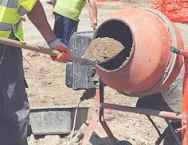CONCRETE
Concrete is a composite material composed mainly of water, aggregate, and cement. Often, additives and reinforcements are included in the mixture to achieve the desired physical properties of the finished material. When these ingredients are mixed together, they form a fluid mass that is easily molded into shape. Over time, the cement forms a hard matrix which binds the rest of the ingredients together into a durable stone-like material with many uses.
The aim is to mix these materials in measured amounts to make concrete that is easy to: Transport, place, compact, finish and which will set, and harden, to give a strong and durable product. The amount of each material (ie cement, water and aggregates) affects the properties of hardened concrete.
Production of concrete
A good quality concrete is essentially a homogeneous mixture of cement, coarse and fineaggregates and water which consolidates into a hard mass due to chemical action between the cement and water. Each of the four constituents has a specific function. The coarser aggregate acts as a filler. The fine aggregate fills up the voids between the paste and the coarse aggregate. The cement in conjunction with water acts as a binder. The mobility of the mixture is aided by the cement paste, fines and nowadays, increasingly by the use of admixtures.The stages of concrete productionare:Batching or measurement of materials, Mixing, Transporting, Placing, Compacting, Curing andFinishing.
Batching
It i s the process of measuring concrete mix ingredients either by volume or by mass and introducing them into the mixture. Traditionally batching is done by volume but most specifications require that batching be done by mass rather than volume.The proportions of various ingredients are determined by proper mix design.
A concrete mix is designed to produce concrete that can be easily placed at the lowest cost. The concrete must be workable and cohesive when plastic, then set and harden to give strong and durable concrete. The mix design must consider the environment that the concrete will be in; ie exposure to sea water, trucks, cars, forklifts, foot traffic or extremes of hot and cold. Proportioning concrete is a mixture of cement, water, coarse and fine aggregates and admixtures. The proportions of each material in the mixture affects the properties of the final
23 * Under revision
hardened concrete. These proportions are best measured by weight. Measurement by volume is not as accurate, but is suitable for minor projects.
Cement content as the cement content increases, so does strength and durability. Therefore to increase the strength, increase the cement content of a mix. WaterContent adding more water to a mix gives a weaker hardened concrete. Always use as little water as possible, only enough to make the mix workable.Water to cement ratio as the water to cement ratio increases, the strength and durability of hardened concrete decreases. To increase the strength and durability of concrete, decrease the water-cement ratio.Aggregates too much fine aggregate gives a sticky mix. Too much coarse aggregate gives a harsh or boney mix.Mixing concrete must be mixed so the cement, water, aggregates and admixtures blend into an even mix. Concrete is normally mixed by machine. Machine mixing can be done on-site or be a pre-mixed concrete company. Pre-mixed concrete is batched (proportioned) at the plant to the job requirements. Truck mixing the materials are normally added to the trucks at batching plants and mixed for required time and speed at the plant. The trucks drum continues to rotate to agitate the concrete as it is delivered to the site. Site mixing when site mixing begin by loading a measured amount of coarse aggregate into the mixer drum. Add the sand before the cement, both in measured amounts.
Mixing
The mixing operation consists of rotation or stirring, the objective being to coat the surface the all aggregate particles with cement paste, and to blind all the ingredients of the concrete into a uniform mass; this uniformity must not be disturbed by the process of discharging from the mixer. The mixing may done by manually or by mechanical means like, Batch mixer, Tilting drum mixer, Non tilting drum mixer, Pan type mixer, Dual drum mixer or Continuous mixers.
There are no general rules on the order of feeding the ingredients into the mixer as this depend on the properties of the mixer and mix. Usually a small quantity of water is fed first, followed by all the solids materials. If possible greater part of the water should also be fed during the same time, the remainder being added after the solids. However, when using very dry mixes in drum mixers it is necessary to feed the coarse aggregate just after the small initial water feed in order to ensure that the aggregate surface is sufficiently wetted.
24 * Under revision


